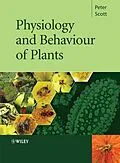Physiology and Behaviour of Plants looks at plants and how they sense and respond to their environment. It takes the traditional plant physiology book into a new dimension by demonstrating how the biochemical observations underlie the behaviour of the plant. In many ways the book parallels courses studied at university on animal physiology and behaviour. The plant has to meet the same challenges as an animal to survive, but overcomes these challenges in very different ways. Students learn to think of plants not only as dynamic organisms, but aggressive, territorial organisms capable of long-range communication.
Hallmark features include:
* Based on a successful course that the author has run for several years at Sussex University, UK
* Relates plant biochemistry to plant function
* Printed in four colour throughout
* Includes a wealth of illustrations and photographs that engages the reader's attention and reinforce key concepts explored within the text
* Presents material in a modern 'topic' based approach, with many relevant and exciting examples to inspire the student
* An accompanying web site will include teaching supplements
This innovative textbook is the ultimate resource for all students in biology, horticulture, forestry and agriculture.
Companion website for this title is available at www.wiley.com/go/scott/plants
Autorentext
Having first been excited by the complexity and beauty of the plant kingdom as a student in Cambridge, Peter Scott is now Senior Lecturer in Plant Biology at the University of Sussex, where his research interests include orchids, resurrection plants and helping students to understand the wonder of the natural world around them.
Zusammenfassung
Physiology and Behaviour of Plants looks at plants and how they sense and respond to their environment. It takes the traditional plant physiology book into a new dimension by demonstrating how the biochemical observations underlie the behaviour of the plant. In many ways the book parallels courses studied at university on animal physiology and behaviour. The plant has to meet the same challenges as an animal to survive, but overcomes these challenges in very different ways. Students learn to think of plants not only as dynamic organisms, but aggressive, territorial organisms capable of long-range communication.
Hallmark features include:
- Based on a successful course that the author has run for several years at Sussex University, UK
- Relates plant biochemistry to plant function
- Printed in four colour throughout
- Includes a wealth of illustrations and photographs that engages the reader's attention and reinforce key concepts explored within the text
- Presents material in a modern 'topic' based approach, with many relevant and exciting examples to inspire the student
- An accompanying web site will include teaching supplements
This innovative textbook is the ultimate resource for all students in biology, horticulture, forestry and agriculture.
Companion website for this title is available at www.wiley.com/go/scott/plants
Inhalt
Chapter 1 Introducing Plants
Introduction
The beginning: the evolution of plants and the major divisions
Conquering the land
The evolution of lignin
Plants and mass extinction
Floristic kingdoms, Biogeography and Biomes
What makes a plant?
Structure of the whole plant
Structure of the plant cell
The chloroplast
The vacuole
Microbodies
The cell wall
Plasmodesmata
References
Figure Legends
Chapter 2 Photosynthesis the ultimate in autotrophy
Introduction
Light harvesting
Leaf form
Chlorophyll and the chloroplast
Converting light energy into chemical energy
The Calvin cycle
Photorespiration
Carbohydrate synthesis and storage
The fate of carbon fixed during photosynthesis
The efficiency of photosynthesis
References
Figure Legends
Chapter 3 Nonphotosynthetic metabolism
Introduction
Phloem transport
Structure of the phloem
Coping with damage to the phloem
The sink tissues
Sink regulation of photosynthesis
References
Figure Legends
Chapter 4 Roots and the uptake of water
Introduction
Types of root
Functions of roots
Structure of roots
Osmosis
Loading and movement in the xylem
Stomata
References
Figure legends
Chapter 5 Mineral nutrition of plants
Introduction
Soil structure and mineral ions
General ion uptake
Phosphorus uptake and assimilation
Nitrogen uptake and assimilation
Iron uptake and assimilation
Sulphur uptake and assimilation
Function and effects of deficiencies of mineral ions on plants
Major elements
Minor elements
References
Figure legends
Chapter 6 Mycorrhizal Associations and Saprophytic Nutrition
Introduction
Mycorrhizal associations
Vesicular arbuscular mycorrhizal associations
Orchidaceous mycorrhizal associations
Ectomycorrhiza
Ericaceous mycorrhiza
Ectendomycorrhiza
Development of the mycorrhizal association
The role of the mycorrhizal association
Saprophytic nutrition
References
Figure Legends
Chapter 7 Parasitic plants
Introduction
Establishing a parasitic relationship
Facultative parasitic plants
Obligate parasitic plants, hemi-parasites
Obligate parasitic plants, holo-parasites
Parasitic species other than the dicotyledons
References
Tables
Figure Legends
Chapter 8 Carnivorous Plants
Introduction
Carnivory: the search for a definition
Why have some plants turned to carnivory?
Bladderworts (genus Utricularia)
Sundews (genus Drosera)
References
Background general reading
Figure Legends
Chapter 9 Asexual and Sexual Reproduction
Introduction
Asexual Reproduction
Roots
Stems
Leaves
Apomixis
Sexual Reproduction
Wind based pollination
Insect based pollination
Pollination
Mechanisms for improving cross fertilisation
Self incompatibility mechanisms
Trifolium repens
Apple (Malus)
Papaver rhoeas
Petunia hybrida
Petunia inflata
Seed development
References
Figure Legends
Chapter 10 Plant growth
Introduction
Types of growth
Cell division and the cell cycle
Polyploidy in plants
Seed formation and germination
The dividing meristem
Flower development
Vascular cambium and secondary growth
Intercalary meristem
Cell death
Plant growth regulators and cell growth
References
Figure Legends
Chapter 11 Plant Movement
Introduction
Tropism and nastic movements
Tropic movements
Nastic movements
Circumnutation
References
Figure Legends<…
